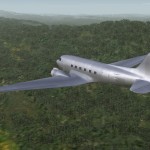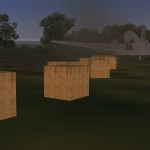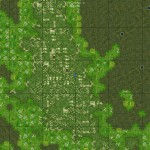Target
Smuggle 240 kilos of marijuana bundles from Ciudad Obregon to Rancho San Rafael across the Arizona border.
Aircraft
C-47B unmarked
Operator
unknown
Payload
240 kilos Marijuana in bundles.
Delivery Parameters
CTRL_O to open cargo doors when on ground. Select Dope and drop the packages.
Event
“The objective of the [Operation Intercept] program,” Secretary of the Treasury David M. Kennedy and Attorney General John N. Mitchell declared in a joint statement released at precisely 2:30 P.m. on Sunday, September 21, 1969, “is to reduce the volume of narcotics, marijuana, and dangerous drugs which are smuggled into the United States from Mexico.” 5 The statement added that “more than 80 percent of the marijuana smoked in the United States” entered the country illegally from Mexico. If this 80 percent could be cut off, all would be well. That, at least, was the official hope.
Mexican distributors are changing smuggling methods. Checked at the normal crossing points, they have started to probe the fences along remote mountain trails and in the desolate flatlands where Mexican roads parallel the border by fewer than 100 yards.” An undetermined amount of marijuana and other drugs was also being smuggled in by plane despite newly installed FAA radar equipment and Air Force intercept planes lent for the operation. “Recently positioned radar installations… showed the blips of intruding aircraft from the south but the blips faded from scanning screens as the planes dropped between mountain ranges and canyon corridors or passed beyond range of the truck mounted sensors.” This discovery by drug smugglers of the vulnerability of the United States Mexican border to aerial intrusion was to have disastrous aftereffects. Long after Operation Intercept itself was discontinued, aerial smugglers continued to use the techniques pioneered in September 1969.
“They fly low and slow, by the light of the moon, and make $50,000 a night,” Robert Lindsey reported in the New York Times in November 1971.”
“They use some private planes and old military transports and land on deserted airstrips or sagebrush-covered desert. Their cargo is marijuana, cocaine and heroin.
“Along the sparsely settled frontier that divides the United States and Mexico, airborne drug-runners are doing a booming business, and Federal agents say they do not know how to stop them.
“On most nights, the agents estimate, at least 10 planes cross the border with marijuana and other drugs. On rare occasions, the smugglers are caught by United States agents flying their own planes. But usually they land unnoticed….”
“Anybody who knows how to fly can get into the business and make a lot of money…… one customs agent was quoted as saying; and an official of the Bureau of Narcotics and Dangerous Drugs added: “They’re developing their own air force, and it’s getting bigger and bigger.”
Most of the planes used were small, but a Department of justice official noted that recently, “a lot of them are starting to use bigger planes–– DC-3’s, surplus military transports, turbo-prop executive planes, and we have our eye on one group that has a Constellation.”
Game Play
Use the Map and waypoints to navigate to the landing zone in Arizona but do not rely upon the Autopilot. You need to fly on the deck below ridges and up river courses. Look for the bare ground marked by fire pits. Stop before you hit the trees. Drop your packages there.
Aircraft Animation Controls: See Preflight screen at mission start.
Intel
- Bundles
- Map View


